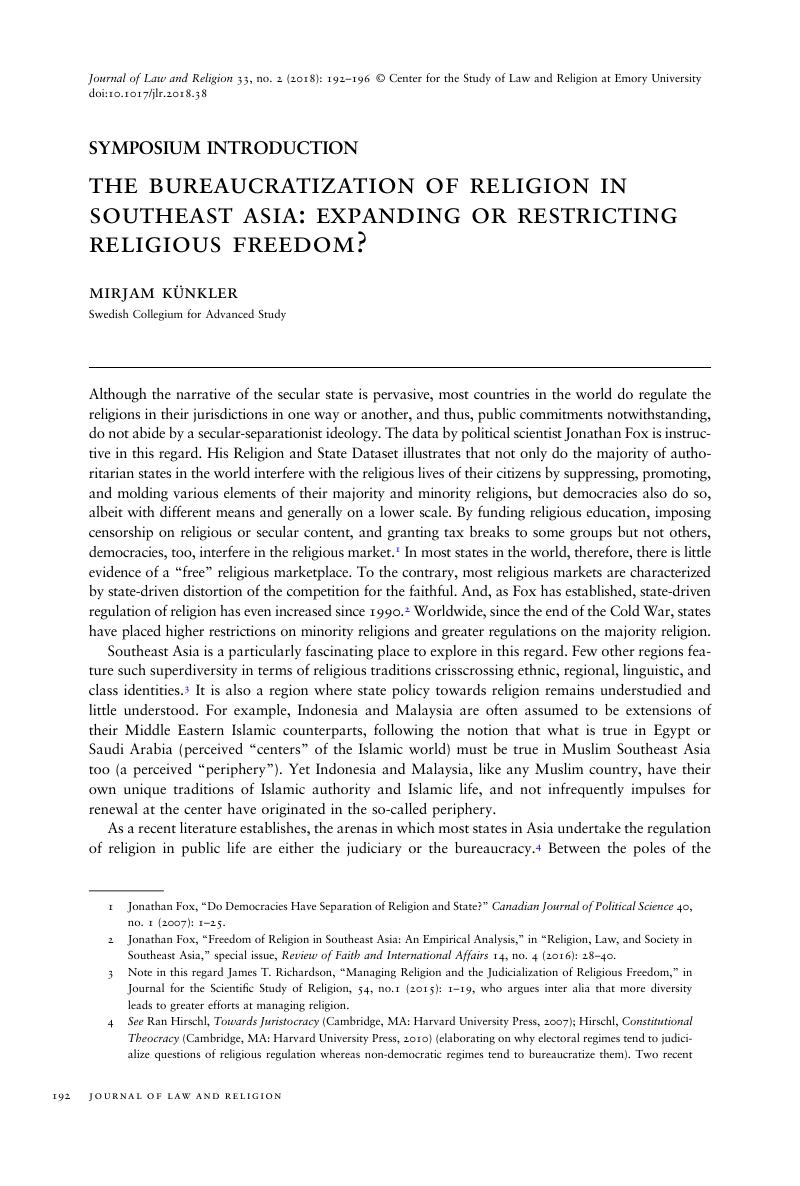Article contents
THE BUREAUCRATIZATION OF RELIGION IN SOUTHEAST ASIA: EXPANDING OR RESTRICTING RELIGIOUS FREEDOM?
Published online by Cambridge University Press: 19 December 2018
Abstract

- Type
- Symposium Introduction
- Information
- Copyright
- Copyright © Center for the Study of Law and Religion at Emory University 2018
References
1 Fox, Jonathan, “Do Democracies Have Separation of Religion and State?” Canadian Journal of Political Science 40, no. 1 (2007): 1–25CrossRefGoogle Scholar.
2 Fox, Jonathan, “Freedom of Religion in Southeast Asia: An Empirical Analysis,” in “Religion, Law, and Society in Southeast Asia,” special issue, Review of Faith and International Affairs 14, no. 4 (2016): 28–40CrossRefGoogle Scholar.
3 Note in this regard Richardson, James T., “Managing Religion and the Judicialization of Religious Freedom,” in Journal for the Scientific Study of Religion, 54, no.1 (2015): 1–19CrossRefGoogle Scholar, who argues inter alia that more diversity leads to greater efforts at managing religion.
4 See Hirschl, Ran, Towards Juristocracy (Cambridge, MA: Harvard University Press, 2007)Google Scholar; Hirschl, , Constitutional Theocracy (Cambridge, MA: Harvard University Press, 2010)Google Scholar (elaborating on why electoral regimes tend to judicialize questions of religious regulation whereas non-democratic regimes tend to bureaucratize them). Two recent eleborate case studies in this regard are Saeed, Sadia, Politics of Desecularization: Law and the Minority Question in Pakistan (New York: Cambridge University Press, 2017)Google Scholar and Moustafa, Tamir, Constituting Religion: Islam, Liberal Rights, and the Malaysian State (New York: Cambridge University Press, 2018)CrossRefGoogle Scholar.
5 Robinson, Francis, “Crisis of Authority: Crisis of Islam?” Journal of the Royal Asiatic Society 19, no. 3 (2009), 339–54CrossRefGoogle Scholar.
6 Weber, Max, On Charisma and Institution Building, ed. Eisenstadt, S. N. (Chicago: University of Chicago Press, 1968), 66–77Google Scholar; see also, Weber, Max, Economy and Society: An Outline of Interpretive Sociology, ed. Roth, Guenther and Wittich, Claus, 2 vols. (Berkeley: University of California Press, 1978)Google Scholar.
7 Eisenstadt, S. N., “Bureaucracy, Bureaucratisation, Markets, and Power Structure,” in Essays on Comparative Institutions (New York: John Wiley & Sons, 1965), 177–215Google Scholar, at 179.
8 Eickelman, Dale F., “Mass Higher Education and the Religious Imagination in Contemporary Arab Societies,” American Ethnologist 19, no. 4 (1992): 643–55CrossRefGoogle Scholar.
9 Eickelman, “Mass Higher Education and the Religious Imagination in Contemporary Arab Societies,” 647.
10 Starrett, Gregory, Putting Islam to Work: Education, Politics, and Religious Transformation in Egypt (Berkeley: University of California Press, 1998), 8–9CrossRefGoogle Scholar.
11 Starrett, Putting Islam to Work, 9–10.
12 Mirjam Künkler and Yüksel Sezgin, “The Unification of Law and the Postcolonial State: Limits of State Monism in India and Indonesia,” in “Constitutionalism in Rough Seas: Balancing Religious Accommodation and Human Rights in, through, and despite, the Law,” ed. Mirjam Künkler, Hanna Lerner, and Shankar, Shylashri, special issue, American Behavioral Scientist 60, no. 8 (2016): 987–1012CrossRefGoogle Scholar.
13 Sezgin, Yüksel and Künkler, Mirjam, “Regulation of Religion and the Religious: The Politics of Judicialization and Bureaucratization in India and Indonesia,” Comparative Studies of Society and History 56, no. 2 (2014): 448–78CrossRefGoogle Scholar.
14 Scharffs, Brett G., “Trends in Regulating Religion in Southeast Asia: Differentiating Core, Important, and Desirable Factors Regarding Religion and the Rule of Law” The Review of Faith & International Affairs 14, no. 4 (2016): 16-27CrossRefGoogle Scholar; Jonathan Fox, “Freedom of Religion in Southeast Asia.”
- 6
- Cited by




